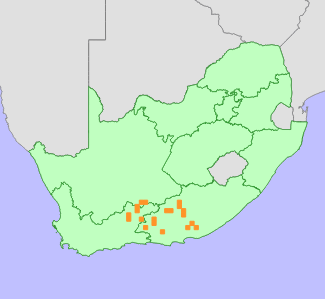|
Scientific Name | Astroloba congesta (Salm-Dyck) Uitewaal |
Higher Classification | Monocotyledons |
Family | ASPHODELACEAE |
Synonyms | Aloe congesta Salm-Dyck, Aloe deltoidea Hook.f., Apicra congesta (Salm-Dyck) Baker, Astroloba deltoidea (Hook.f.) Uitewaal, Astroloba deltoidea (Hook.f.) Uitewaal var. intermedia (A.Berger) Uitewaal, Astroloba turgida (Baker) H.Jacobsen (invalidly published), Haworthia congesta (Salm-Dyck) Parr, Haworthia deltoidea (Hook.f.) Parr, Haworthia deltoidea (Hook.f.) Parr var. intermedia (A.Berger) Parr, Haworthia deltoidea (Hook.f.) Parr var. turgida (A.Berger) Parr, Haworthia shieldsiana Parr, Tulista congesta (Salm-Dyck) G.D.Rowley |
National Status |
Status and Criteria | Least Concern |
Assessment Date | 2016/11/10 |
Assessor(s) | D. Raimondo |
Justification | Astroloba congesta is widespread and near-endemic to the Karoo Basin. The extent of occurrence (EOO) is 52 644 km². It is not currently threatened and listed as Least Concern, but planned future shale gas extraction may have significant impacts on habitat extent and quality across this species' range in the future, possibly leading to an increasing risk of extinction. |
Distribution |
Endemism | South African endemic |
Provincial distribution | Eastern Cape |
Range | This species is endemic to South Africa, and is found from Prince Albert to Victoria West and east to Cradock and Grahamstown. |
Habitat and Ecology |
Major system | Terrestrial |
Major habitats | Eastern Upper Karoo, Upper Karoo Hardeveld, Eastern Lower Karoo, Gamka Karoo, Tarkastad Montane Shrubland, Karoo Escarpment Grassland, Southern Karoo Riviere, Fish Arid Thicket, Escarpment Arid Thicket, Eastern Gwarrieveld, Doubledrift Karroid Thicket, Albany Valley Thicket |
Description | It grows in Karroid flats. |
Threats |
| There are currently no severe threats to this species. However, most of its distribution range falls within an area earmarked for shale gas extraction. Depending on how widespread and severe the impact of extraction is (it is not currently possible to estimate), this species may decline significantly within a short time frame, possibly becoming in danger of extinction in future. |
Population |
There is no information about the species' population.
|
Population trend | Stable |
Assessment History |
Taxon assessed |
Status and Criteria |
Citation/Red List version | | Astroloba congesta (Salm-Dyck) Uitewaal | Least Concern | Raimondo et al. (2009) | |
Bibliography |
Bredenkamp, C. In prep. Conspectus of the flora of the Eastern cape. Strelitzia.
Manning, J.C., Boatwright, J.S., Daru, B.H., Maurin, O. and Van der Bank, M. 2014. A molecular phylogeny and generic classification of Asphodelaceae subfamily Alooideae: A final resolution of the prickly issue of polyphyly in the Alooids? Systematic Botany 39(1):55-74.
Raimondo, D., von Staden, L., Foden, W., Victor, J.E., Helme, N.A., Turner, R.C., Kamundi, D.A. and Manyama, P.A. 2009. Red List of South African Plants. Strelitzia 25. South African National Biodiversity Institute, Pretoria.
Rowley, G.D. 2013. Generic concepts in the Alooideae. Part 3 - The phylogenetic story. Alsterworthia International Special Issue 10:1-6.
|
Citation |
| Raimondo, D. 2016. Astroloba congesta (Salm-Dyck) Uitewaal. National Assessment: Red List of South African Plants version 2024.1. Accessed on 2025/11/15 |
 Comment on this assessment
Comment on this assessment


